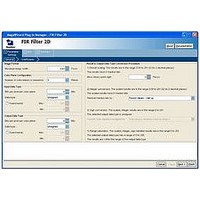IPS-VIDEO Altera, IPS-VIDEO Datasheet - Page 126

IPS-VIDEO
Manufacturer Part Number
IPS-VIDEO
Description
MegaCore Suite W/ 17 DSP Video/image Processing Functions
Manufacturer
Altera
Type
-r
Specifications of IPS-VIDEO
Software Application
IP CORE, SUITES
Supported Families
Arria GX, Cyclone II, HardCopy II, Stratix II
Core Architecture
FPGA
Core Sub-architecture
Arria, Cyclone, Stratix
Rohs Compliant
NA
Function
Suite of IP Functions for Video and Image Processing
License
Initial License
Lead Free Status / RoHS Status
na
Lead Free Status / RoHS Status
na
- Current page: 126 of 214
- Download datasheet (6Mb)
5–42
Video and Image Processing Suite User Guide
1
If the input is 4:2:2 Y’CbCr subsampled data, the compatibility mode for 4:2:2 data
should be enabled to prevent the motion adaptive algorithm from introducing
chroma artefacts when using bob deinterlacing for moving regions.
Use the Motion bleed algorithm to prevent the motion value from falling too fast at a
specific pixel position. If the motion computed from the current and the previous
pixels is higher than the stored motion value, the stored motion value is irrelevant and
the function uses the computed motion in the blending algorithm, which becomes the
next stored motion value. However, if the computed motion value is lower than the
stored motion value, the following actions occur:
■
■
This computed motion means that the motion that the blending algorithm uses climbs
up immediately, but takes about four or five frames to stabilize.
The motion-adaptive algorithm fills in the rows that are missing in the current field by
calculating a function of other pixels in the current field and the three preceding fields
as shown in the following sequence:
1. Pixels are collected from the current field and the three preceding it (the X denotes
Figure 5–22. Pixel Collection for the Motion-Adaptive Algorithm
2. These pixels are assembled into two 3×3 groups of pixels.
Figure 5–23. Pixel Assembly for the Motion-Adaptive Algorithm
3. The minimum absolute difference value is normalized into the same range as the
The blending algorithm uses the stored motion value
The next stored motion value is an average of the computed motion and of the
stored motion
the location of the desired output pixel)
minimum absolute difference of the two groups.
input pixel data. If you select the Motion bleed algorithm, the function compares
the motion value with a recorded motion value for the same location in the
previous frame. If it is greater, the function keeps the new value; if the new value is
less than the stored value, the function uses the motion value that is the mean of
the two values. This action reduces unpleasant flickering artefacts but increases
the memory usage and memory bandwidth requirements.
Motion = MAD
C - 3
C - 2
Previous Frame
(Figure
C - 1
5–22).
,
Current Frame
Current Field (C)
Chapter 5: Functional Descriptions
Figure
May 2011 Altera Corporation
X
5–23shows the
Deinterlacer
Related parts for IPS-VIDEO
Image
Part Number
Description
Manufacturer
Datasheet
Request
R

Part Number:
Description:
CYCLONE II STARTER KIT EP2C20N
Manufacturer:
Altera
Datasheet:

Part Number:
Description:
CPLD, EP610 Family, ECMOS Process, 300 Gates, 16 Macro Cells, 16 Reg., 16 User I/Os, 5V Supply, 35 Speed Grade, 24DIP
Manufacturer:
Altera Corporation
Datasheet:

Part Number:
Description:
CPLD, EP610 Family, ECMOS Process, 300 Gates, 16 Macro Cells, 16 Reg., 16 User I/Os, 5V Supply, 15 Speed Grade, 24DIP
Manufacturer:
Altera Corporation
Datasheet:

Part Number:
Description:
Manufacturer:
Altera Corporation
Datasheet:

Part Number:
Description:
CPLD, EP610 Family, ECMOS Process, 300 Gates, 16 Macro Cells, 16 Reg., 16 User I/Os, 5V Supply, 30 Speed Grade, 24DIP
Manufacturer:
Altera Corporation
Datasheet:

Part Number:
Description:
High-performance, low-power erasable programmable logic devices with 8 macrocells, 10ns
Manufacturer:
Altera Corporation
Datasheet:

Part Number:
Description:
High-performance, low-power erasable programmable logic devices with 8 macrocells, 7ns
Manufacturer:
Altera Corporation
Datasheet:

Part Number:
Description:
Classic EPLD
Manufacturer:
Altera Corporation
Datasheet:

Part Number:
Description:
High-performance, low-power erasable programmable logic devices with 8 macrocells, 10ns
Manufacturer:
Altera Corporation
Datasheet:

Part Number:
Description:
Manufacturer:
Altera Corporation
Datasheet:











